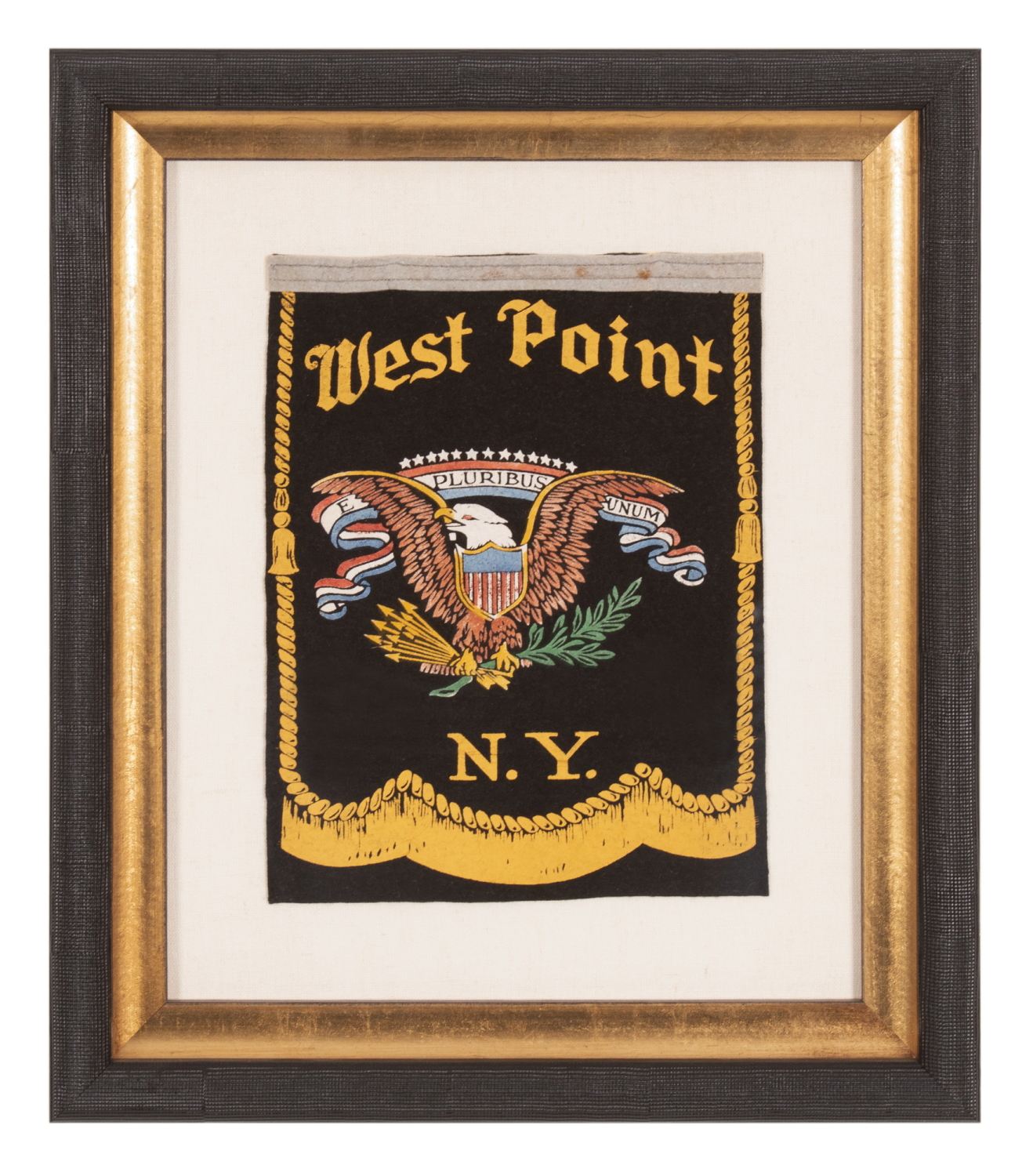
| |
WEST POINT WINDOW BANNER OF THE WWI – WWII ERA (1917-1945), WITH STRONG COLORS & GRAPHICS |
|
| Available: |
Sold |
| Frame Size (H x L): |
17.75" x 15" |
| Flag Size (H x L): |
10.75" x 8.25" |
|
| Description....: |
|
Small window banner, made for the United States Military Academy at West Point. Printed in a saturated shade of golden yellow, complemented by red, white, blue, rust, and green, the black felt ground creates great contrast. Made sometime in the WWI - WWII era, the patriotic device in the center is a loose interpretation of the Great Seal of The United States, with most of the basic elements, but in a stylistically altered and elongated fashion. 13 stars are slightly arched above an unusually long, billowing, red, white, and blue streamer with the expected Latin motto: “E Pluribus Unum” text (out of many, one). The eagle clutches arrows in its proper right talon and an olive branch in its proper left. Its head faces the arrows, which may signify that the device was of wartime origin. I would suggest that the image is likely to have originated with WWI patriotism (U.S. involvement 1917-18). The pennant itself could have been made anytime between this general timeframe and WWII (U.S. involvement 1941-45).
Much to-do was made about the position of the eagle’s head in WWII’s closing year. In March of 1945, President Franklin Delano Roosevelt, who had served as Secretary of the Navy during WWI, began to address a change in U.S. Navy signals. Though he passed in April of that year, this ignited discussions between President Harry Truman, who followed, and the U.S. Army’s chief of heraldry, Arthur DuBois, concerning the position of the eagle on the Great Seal, which had no formal, written definition. The outgrowth of this was Presidential Order 9646, issued on October 25th, 1945, which set forth certain characteristics, including the way the head of the eagle must face, to its proper right, and the location of the olive branch in the right talon, to indicate a time of peace. This came close on the heels of Nazi surrender to Allied Forces, that took place on September 2nd. It seems unlikely that either a maker of West Point pennants, or the institution itself, would have afterwards continued to manufacture or procure flags or related textiles with the head of the eagle facing the arrows, though an example acquired by a family in November of 1970, similar in form, but printed on a different sort of felt fabric, bears the same basic emblem.
Unlike the official layout of the American national flag, which has stripes that begin and end on red, the stripes on a heraldic shield are, according to the rules of heraldry, supposed to begin and end on white. Deviations of this sort are so ramped in early American patriotic devices that variation tends to be the rule, as opposed to the exception. Flag collectors tend to favor intriguing peculiarities such as these, since it makes them more interesting. One may note that even with hallowed institutions, such as West Point, which thrive on proper etiquette, order, and presentation, details such as these, in early flags, banners, and the like, persisted for decades.
Golden yellow text above the device reads “West Point” in old English script, in a pitched pediment format, with a simple “N.Y.” in traditional Roman letters below. All of the above appears within a three-sided border of twisted, gold rope, decorated with tassels and fringe. There is a white felt binding along the top, applied with machine stitching.
This is a great, early printing, produced in the manner of the first felt pennants, which appeared around 1908. Made to be hung in the window of a cadet’s family, the production and use of this particular form probably emerged with that of son-in-service banners, in 1917, which were to be displayed when a family had a child in military service during wartime. A West Point banner like this would likely be hung beside a service banner, but could, of course, be hung outside times of war, as well, as a reflection of admission to the Academy. An almost identical version was made for the presidential campaign of Catholic, New Yorker Al Smith in 1928, with his portrait image cradled between crossed flags. A very similar design, in the same basic scale, yet with a slightly different border, was produced with varying, central images and text, for the 1936 and 1940 presidential campaigns of F.D.R.
Whatever the case may be with regard to official specifications, this is a beautiful patriotic object with great colors and graphics, from America’s most hallowed military institution.
Mounting: The pennant was mounted and framed within our own conservation department, which is led by expert staff. We take great care in the mounting and preservation of flags and have framed thousands of examples.
The background is 100% natural hemp fabric or a hemp and cotton blend, ivory in color, with a twill weave. The two-part frame consists of a black-painted, shadowbox style molding with a bowed face and a textured surface, to which a black-painted and hand-gilded Italian molding, with a scooped profile, was added as a liner. The glazing is U.V. protective glass.
Condition: There is minor soiling along the white felt binding from metal tacks used to affix the banner to a staff or a fixed object. Many of my clients prefer early flags to show their age and history of use. |
|
|
|
| Collector Level: |
Beginners and Holiday Gift Giving |
|
| Flag Type: |
|
|
| Star Count: |
|
|
| Earliest Date of Origin: |
1917 |
|
| Latest Date of Origin: |
1945 |
|
| State/Affiliation: |
New York |
|
| War Association: |
|
|
| Price: |
SOLD |
|
| |
Views: 48 |
|
|
|

